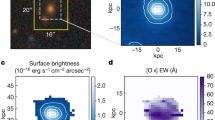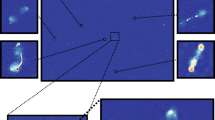Abstract
THE radio source Cassiopeia A (Cas A) is believed to be the remnant of a type II supernova that occurred in our galaxy about 280 yr ago (refs 1 and 2). The radio remnant forms an irregular shell of radius ∼2′, corresponding to ∼1.6 pc at its distance of 2.8 kpc (ref. 2), which is broadly coincident with an incomplete shell of fast-moving optical knots1. We present here a new radio map of the source with a resolution three times greater than has previously been achieved3.
This is a preview of subscription content, access via your institution
Access options
Subscribe to this journal
Receive 51 print issues and online access
$199.00 per year
only $3.90 per issue
Buy this article
- Purchase on Springer Link
- Instant access to full article PDF
Prices may be subject to local taxes which are calculated during checkout
Similar content being viewed by others
References
Minkowski, R., Nebulae and Interstellar Matter (edit. by Bracewell, R. N.), (Stanford University Press, Stanford, 1968).
van den Bergh, S., and Dodd, W. W., Astrophys. J., 162, 485–493 (1970).
Rosenberg, I., Mon. Not. R. astr. Soc., 151, 109–122 (1970).
Ryle, M., Nature, 239, 435 (1972).
Gull, S. F., Mon. Not. R. astr. Soc., 161, 47–69 (1973).
Gull, S. F., Mon. Not. R. astr. Soc., 171, 263–278 (1975).
Author information
Authors and Affiliations
Rights and permissions
About this article
Cite this article
BELL, A., GULL, S. & KENDERDINE, S. New radio map of Cassiopeia A at 5 GHz. Nature 257, 463–465 (1975). https://doi.org/10.1038/257463a0
Received:
Accepted:
Issue Date:
DOI: https://doi.org/10.1038/257463a0
This article is cited by
-
The origin of galactic cosmic rays
Reviews of Modern Plasma Physics (2022)
-
Detection of change in rotation measure of the Vela pulsar
Nature (1977)
-
Is Cas A illuminated by a binary system?
Nature (1977)
-
Effect of nearby supernova explosions on atmospheric ozone
Nature (1976)
Comments
By submitting a comment you agree to abide by our Terms and Community Guidelines. If you find something abusive or that does not comply with our terms or guidelines please flag it as inappropriate.



